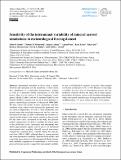| dc.contributor.author | Smith, Molly B. | |
| dc.contributor.author | Mahowald, Natalie M. | |
| dc.contributor.author | Albani, Samuel | |
| dc.contributor.author | Perry, Aaron | |
| dc.contributor.author | Losno, Remi | |
| dc.contributor.author | Qu, Zihan | |
| dc.contributor.author | Marticorena, Beatrice | |
| dc.contributor.author | Ridley, David Andrew | |
| dc.contributor.author | Heald, Colette L. | |
| dc.date.accessioned | 2017-06-07T19:29:45Z | |
| dc.date.available | 2017-06-07T19:29:45Z | |
| dc.date.issued | 2017-03 | |
| dc.date.submitted | 2016-12 | |
| dc.identifier.issn | 1680-7324 | |
| dc.identifier.issn | 1680-7316 | |
| dc.identifier.uri | http://hdl.handle.net/1721.1/109715 | |
| dc.description.abstract | Interannual variability in desert dust is widely observed and simulated, yet the sensitivity of these desert dust simulations to a particular meteorological dataset, as well as a particular model construction, is not well known. Here we use version 4 of the Community Atmospheric Model (CAM4) with the Community Earth System Model (CESM) to simulate dust forced by three different reanalysis meteorological datasets for the period 1990–2005. We then contrast the results of these simulations with dust simulated using online winds dynamically generated from sea surface temperatures, as well as with simulations conducted using other modeling frameworks but the same meteorological forcings, in order to determine the sensitivity of climate model output to the specific reanalysis dataset used. For the seven cases considered in our study, the different model configurations are able to simulate the annual mean of the global dust cycle, seasonality and interannual variability approximately equally well (or poorly) at the limited observational sites available. Overall, aerosol dust-source strength has remained fairly constant during the time period from 1990 to 2005, although there is strong seasonal and some interannual variability simulated in the models and seen in the observations over this time period. Model interannual variability comparisons to observations, as well as comparisons between models, suggest that interannual variability in dust is still difficult to simulate accurately, with averaged correlation coefficients of 0.1 to 0.6. Because of the large variability, at least 1 year of observations at most sites are needed to correctly observe the mean, but in some regions, particularly the remote oceans of the Southern Hemisphere, where interannual variability may be larger than in the Northern Hemisphere, 2–3 years of data are likely to be needed. | en_US |
| dc.description.sponsorship | National Science Foundation (U.S.) (0932946) | en_US |
| dc.description.sponsorship | National Science Foundation (U.S.) (1003509) | en_US |
| dc.description.sponsorship | United States. Department of Energy (DE-SC0006735) | en_US |
| dc.description.sponsorship | United States. Department of Energy (DE-SC0016362) | en_US |
| dc.description.sponsorship | United States. National Aeronautics and Space Administration (NN14AP38G) | en_US |
| dc.language.iso | en_US | |
| dc.publisher | Copernicus GmbH | en_US |
| dc.relation.isversionof | http://dx.doi.org/10.5194/acp-17-3253-2017 | en_US |
| dc.rights | Creative Commons Attribution 3.0 Unported license | en_US |
| dc.rights.uri | http://creativecommons.org/licenses/by/3.0/ | en_US |
| dc.source | Copernicus Publications | en_US |
| dc.title | Sensitivity of the interannual variability of mineral aerosol simulations to meteorological forcing dataset | en_US |
| dc.type | Article | en_US |
| dc.identifier.citation | Smith, Molly B.; Mahowald, Natalie M.; Albani, Samuel; Perry, Aaron; Losno, Remi; Qu, Zihan; Marticorena, Beatrice; Ridley, David A. and Heald, Colette L. “Sensitivity of the Interannual Variability of Mineral Aerosol Simulations to Meteorological Forcing Dataset.” Atmospheric Chemistry and Physics 17, no. 5 (March 7, 2017): 3253–3278 © Author(s) 2017 | en_US |
| dc.contributor.department | Massachusetts Institute of Technology. Department of Civil and Environmental Engineering | en_US |
| dc.contributor.mitauthor | Ridley, David Andrew | |
| dc.contributor.mitauthor | Heald, Colette L. | |
| dc.relation.journal | Atmospheric Chemistry and Physics | en_US |
| dc.eprint.version | Final published version | en_US |
| dc.type.uri | http://purl.org/eprint/type/JournalArticle | en_US |
| eprint.status | http://purl.org/eprint/status/PeerReviewed | en_US |
| dspace.orderedauthors | Smith, Molly B.; Mahowald, Natalie M.; Albani, Samuel; Perry, Aaron; Losno, Remi; Qu, Zihan; Marticorena, Beatrice; Ridley, David A.; Heald, Colette L. | en_US |
| dspace.embargo.terms | N | en_US |
| dc.identifier.orcid | https://orcid.org/0000-0003-3890-0197 | |
| dc.identifier.orcid | https://orcid.org/0000-0003-2894-5738 | |
| mit.license | PUBLISHER_CC | en_US |
